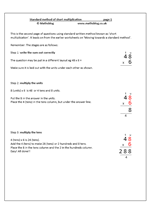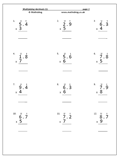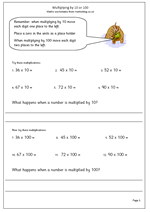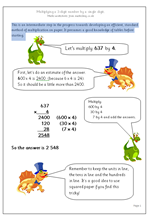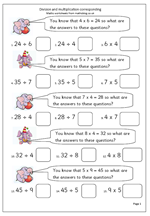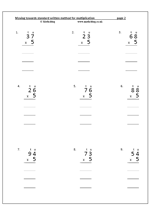 This method of multiplication encourages understanding of the process of multiplying a 2-digit number by a 1-digit number. The questions on this page would not normally be completed using written methods: mental methods should suffice. It would be expected that children could do these ‘in their heads’ from a knowledge of multiplying by 10 and halving. Also, the Primary Framework for Mathematics does not recommend using these types of written method until Year 3 onwards (7/8 years old).
This method of multiplication encourages understanding of the process of multiplying a 2-digit number by a 1-digit number. The questions on this page would not normally be completed using written methods: mental methods should suffice. It would be expected that children could do these ‘in their heads’ from a knowledge of multiplying by 10 and halving. Also, the Primary Framework for Mathematics does not recommend using these types of written method until Year 3 onwards (7/8 years old).
The method is to multiply the units first, then multiply the tens, finally adding the two together. It is a ‘half-way house’ towards the standard written method, explaining what happens when the tens boundary is crossed during multiplying the units (ie when the units come to more than 10). More details are shown on the worksheet pages below.
The stages are as follows:
36 x 5
Step 1: multiply the units
6 x 5 = 30
Put the 30 in the row below the question, making sure the 3 digit is in the tens column.
Step 2: multiply the tens
3 (tens) x 5 is 15 (tens) = 150.
Put the 150 in the row below, again making sure the units and tens
line up.
Step 3: add the two answers
Add the units: 0 + 0 = 0 units
Then add the tens: 3 + 5 = 8 tens
Then add the hundreds: 0 + 1 = 1 hundred
Answer: 180
5x moving towards standard multiplication
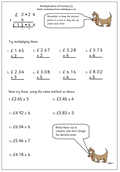 Here we have a straightforward worksheet dealing with the multiplication of money by a single digit.The main concern here is that the process is carried out much as multiplying a 3 or 4-digit number, but remembering the decimal point.
Here we have a straightforward worksheet dealing with the multiplication of money by a single digit.The main concern here is that the process is carried out much as multiplying a 3 or 4-digit number, but remembering the decimal point.